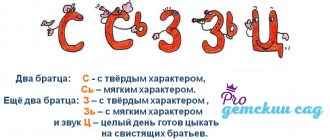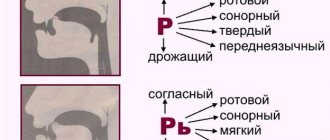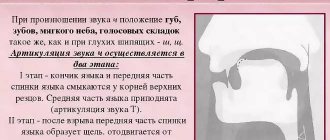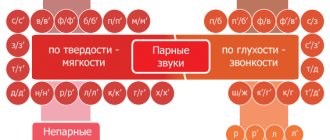Sh pronunciation is normal
This sound is the basic one in the hissing group. Having mastered its articulation, the child will easily learn to correctly pronounce other sounds from this group. The lips take a “horn” position: they are pushed forward a little so that a “window” shape is obtained. When pronouncing a sound, the teeth must be closed.
The tongue should be in a “cup” position: the tip is behind the upper teeth, and its sides are pressed tightly against the teeth. This allows you to direct the exhaled stream in the middle. If everything is done correctly, it will turn out wide and warm. The vocal cords are open, so Ш is a voiceless consonant.
Types and mechanisms of violations
Incorrect pronunciation of a hissing group is called sigmatism, and their replacement with other sounds is called parasigmatism. Sh may be absent from a child’s speech, but he will not replace it with other phonemes. There are several types of hissing sigmatism, differing in the mechanism of occurrence:
- Interdental – speech with such distortion is called a lisp. With this sigmatism, the tongue does not take the desired “cup” position, but passes between the teeth. The cause may be a short hyoid frenulum; high and narrow sky.
- Lateral - in speech, instead of Ш, a sound is produced that has a “squelching” sound. During pronunciation, one corner of the lips rises higher than the other; the lower jaw is also shifted to one side; the “cup” shape does not work out because the back of the tongue forms a connection with the dental alveoli on only one side. The reason for the appearance of such distortion may be weak tone of the articulatory muscles and incorrect bite.
- Nasal - instead of Ш, the child pronounces X with a nasal connotation. The tongue is in a lower position, and the back is raised up. It is because of the high tension on the back of the tongue that this sigmatism appears.
Depending on the type of hissing sigmatism, the speech therapist will select the method of sound production.
Sibilants in a child's speech
Hissing ones include - [w], [zh], [h`], [sch`]. The formation of their correct pronunciation occurs between the third and fifth years of the baby’s life.
Incorrect pronunciation of “Sh”: types, reasons
Distortion or complete absence of sibilants in a child’s speech is called sigmatism. Depending on the type of incorrect placement, there are 4 types of sigmatism:
- Parasigmatism is a stable replacement of [sh] with another sound. Labial-dental - dental - replacement of [w] with [f]. Prizubny - replacing [w] with [t]. Hissing - replacing [w] with [sch]. Whistling - replacing [w] with [s] or [z]. Occurs with malocclusion or impaired phonemic hearing. Example: hat - slipper.
- Interdental sigmatism is the same “lisping” sound. Occurs due to a shortened frenulum or narrow soft palate.
Lesson with a specialist
- Lateral sigmatism - the sound [w] does not sound firm, as it should, but squelching, as if the baby had taken water into his mouth. Observed due to lateral open bite or weak tongue muscles.
- Nasal sigmatism - in a preschooler, the back of the tongue becomes very tense, and [w] can be pronounced with a nasal “echo.”
Before figuring out how to teach a child to pronounce the letter w, you should understand the reasons for the violation. Often a routine visit to the orthodontist, during which the bite or upper palate is corrected, ends with the long-awaited “hissing” of the baby. Otherwise, there is a need to develop the correct articulation pattern in speech therapy classes.
Articulation gymnastics for staging hissing
Before requiring the baby to pronounce a hissing sound, it is necessary to carry out preparatory articulatory gymnastics. Its duration is no more than 10 minutes. Despite the fast pace (so that the preschooler does not get bored), the child must perform each exercise carefully, since gymnastics directly determines how quickly a child can learn to say the sound [w].
Main tasks in articulatory gymnastics:
- Fence - a wide smile with teeth.
- Tube - the lips are gathered into a tube, there is a small gap between the lips.
- Alternating fence - tube.
- Hippopotamus - open your mouth wide and hold it for a while.
- Spatula - place a wide, outstretched tongue on the lower lip. You can “bite” with your tongue to make it wider.
- Homemade jam: lick the upper and then the lower lip with the tip of your tongue.
- Brush - move the tip of your tongue across the soft palate - from the throat to the teeth and back.
Articulation gymnastics
Tasks to determine the position of a sound in a word
At the beginning of the lesson, you can also develop phonemic awareness - determine the position of a sound in a word. To do this, you will need rich verbal and subject material.
- The child is asked to clap if he hears the “snake song (sound [sh]).” In this case, words are pronounced that contain the desired sound or do not contain them. You should not pronounce words with other hissing or mixed whistling sounds.
- The child is given a small sign with 3 windows indicating the beginning, middle and end of the word. And also a chip (cube/drawn sound). The teacher says the condition: “I will name the word, and you put the chip where the sound [w] is located.”
Defectological assistance in educational institutions for preschool children
Gymnastics for clear pronunciation
To correctly pronounce hissing sounds, speech therapy uses articulation and breathing exercises in combination. In this case, you should definitely remember about the correct position of the organs of articulation: lips and tongue.
Additional Information! Breathing exercises are aimed at developing smooth exhalation. To teach your child to perform breathing exercises, you need to create bright and interesting didactic material. For example, a flower with a butterfly sitting on it, which, according to the terms of the task, needs to be blown away.
Methodological basics for parents
It is important to know the correct position of the tongue and lips when pronouncing a sound in order to work on the exercises at home.
- Lips in the “tube” position;
- The tongue is wide, the tip is raised upward;
- The lateral parts of the tongue are in contact with the teeth of the upper jaw;
- A small gap forms between the palate and the tongue in the area of the upper incisors.
Speech therapy diagnostics
The speech therapist evaluates the development of all components of speech to determine a speech defect. In case of distorted pronunciation of sounds during diagnosis, he pays special attention to:
- appearance of the lips, state of the bite, muscle tone of the tongue;
- articulatory and facial motor skills;
- duration and force of exhalation;
- pronunciation of sound in isolation, in syllables, words, phrases and coherent speech;
- whether the child distinguishes it from other phonemes.
When assessing the anatomy of the articulatory apparatus, the specialist looks at the bite, palate, appearance of the tongue (too narrow or clumsy wide), and the hyoid frenulum. If there are any deviations that may be the cause of the distortion, the speech therapist can refer you to other specialists (surgeon, orthodontist).
When checking the work of facial muscles, the speech therapist asks the child to depict emotions (joy, sadness, surprise, etc.); checks how the facial muscles work individually (asks you to raise your eyebrows, smile, etc.); In addition to motor skills, the child is shown images of various emotions and must choose the appropriate mood for each picture.
During the diagnosis of articulatory motor skills, the speech therapist gives tasks for statics (retention) and dynamics:
- Smile, stretch out your lips in a “tube” or take a position as when pronouncing O. You need to fix them in a certain position for a few seconds.
- Move your jaw in different directions.
- Relax your tongue, make it wide, place and hold it on your lower lip, or make it narrow, extending it as far as possible.
- Perform the “cup” exercise.
- Raise - lower the tongue.
- Move them in different directions.
- Draw a horse.
All exercises are performed by demonstration, that is, the adult shows first, and the child then repeats. The speech therapist notes from what time the child was able to complete the task correctly or when he failed; draws attention to the state of muscle tone of the articulatory apparatus.
To check the strength and duration of exhalation, it is suggested to perform the following tasks:
- blow off a light object (feather, piece of cotton wool);
- play the game “Who will kick the ball further” - the child competes with an adult who will blow out the object further;
- play the pipe.
Before performing tasks, the speech therapist explains how to breathe correctly. During diagnosis, he also pays attention to the formation of speech breathing.
When examining the sound-pronunciation aspect of speech, the speech therapist examines all groups of sounds. When a child pronounces a sound, the speech therapist pays attention to the position of the articulation organs. At first, the phoneme is pronounced separately from the others. Then in various syllables (SHA, OSH, USHU, ShPA, etc.); in words, and the sound must be at the beginning, middle or end (HAT, MOUSE, RESED, etc.).
Then the speech material is complicated, and the child repeats phrases and sentences after the adult (BIG EARS, DASHIN'S FUR COAT, WIDE SCARF, etc.). To check the pronunciation of Ш in independent coherent speech, use the following tasks:
- make up a phrase/sentence from the given words;
- who can name more objects that have Sh in their names;
- tell what is drawn in the plot picture.
Speech and visual material should be selected taking into account the child’s age. When checking the pronunciation of a particular sound, you do not need to use words containing mixed groups and oppositional phonemes.
The speech therapist also checks the state of phonemic hearing and the skill of sound-letter analysis. For this purpose, special tasks are selected:
- do some action after hearing a given sound (it is pronounced separately, in combination with other phonemes);
- Determine the position of a sound in a word.
Based on the results of the examination, the speech therapist draws up a plan of correctional work and selects appropriate methods of sound production.
What to do to learn to pronounce “Sh”
Exercise for developing the sound “Ш”.
Correct pronunciation of the sound [w] is possible in this case: the teeth are as close as possible, the incisors are on top of each other, and the rounded lips are pushed forward, the tongue is shaped like a “bucket.”
Guidelines for parents
Sometimes parents do not turn to a speech therapist for various reasons. Some due to financial difficulties, others in accordance with their beliefs. At the same time, parents should know how to teach their child to say the letter “SH”.
Warm up for tongue and lips
The most effective and easy-to-implement way to cope with failure to pronounce sounds is articulatory gymnastics.
It includes the following exercises:
- “Let’s warm our palms.” His goal is to learn how to release a strong stream of air. The child needs to exhale air in even portions with rounded lips, without puffing out his cheeks.
- Naughty tongue. The exercise helps relax the tongue muscles. With the tongue placed on the lower lip, the syllable “five-five-five” is pronounced from 1 to 10, the edges of the tongue do not rise upward.
- Glue on some candy. The result of such training should be strengthened tongue muscles and a practiced upward movement of the tongue. The tip of the tongue is located on the lower lip, a small piece of toffee is placed on the edge, which must be glued to the palate. The jaw should remain motionless, only the tongue works.
- Swing. The tip of the tongue touches either the upper or lower teeth.
- Horse. Clack like a horse.
- Pancake. Place a relaxed tongue on the lower lip.
- Kitty. The child needs to reach his nose with his tongue.
- Focus. You need to open your mouth while smiling and place the edge of your tongue on your upper lip so that a groove is formed in the center; now you need to blow off the cotton wool that lies on your nose.
After warming up and practicing these exercises, you can begin direct sound production.
Exercises for the main stage
A basic exercise for articulating “W” can be using pronouncing “R” in front of a mirror in a whisper. At this time, you need to stop the vibration of the tongue with a spatula.
After completing the exercise with your mouth open, you can proceed to pronouncing the resulting sound, clenching your teeth. The normal sound of “Sh” is achieved by rounding the lips.
The basic one is also “T”, which is pronounced in front of the mirror. After which articulation is reproduced with a half-open mouth, while the front edge of the tongue should touch not the teeth, but the dental sockets. After which the “T” is pronounced at the holes with aspiration.
Articulation and breathing exercises
Before moving on to sound production, the desired articulatory pattern is formed and the strength and duration of exhalation is trained. To pronounce sibilants correctly, the child is taught to make his tongue wide and raise it. The main exercise in the complex is “Cup”. It is this position that forms the basis for the correct articulation of sibilants.
You can begin to perform it once you have developed the ability to make and keep your tongue wide.
First, the classes develop the ability to relax the tongue. To do this, perform patting movements with your lips or lightly bite them with your teeth - these are options for self-massage. They also train in holding the tongue in this position for some time. If difficulties arise with lifting it, select exercises to practice the upper position (“Horse”, “Mushroom”, “Brush your upper teeth” and other similar tasks).
After the child succeeds in all of the above, they begin to perform the “Cup” exercise. The child raises the tip and lateral edges of the tongue and holds them in this position. To increase the effect, you can pour a little water into the “Cup” so that the baby tries to hold it.
Other exercises are also recommended:
- To complete this task you will need cotton wool. A wide tongue is placed on the lower lip. The child says an elongated F and tries to blow off the cotton wool as far as possible.
- The wide tip of the tongue is placed on the upper lip, and the side edges should be pressed tightly. A piece of cotton wool or a feather is placed on the tip of the nose. The child tries to blow it off by holding his tongue in the upper position. He will be able to do this if the air stream passes through the middle.
The listed tasks are aimed not only at developing a long exhalation, but also develop the ability to relax the tongue, make it wide, and in this state lift and hold it behind the teeth. When the speech therapist sees that the child can maintain the necessary articulatory postures, he begins to set the Sh. If the movements are not sufficiently formed and the muscles of the tongue are not strengthened, then the child will not be able to fix the correct position, and the sound will be pronounced only with mechanical assistance. Therefore, the preparatory stage is mandatory in correctional work.
The described exercises for sibilants are also used to correct the pronunciation of a sonorant group of sounds, because when they are pronounced, the tongue also takes an upper position.
Teaching your child to pronounce correctly
Parents whose children pronounce hissing sounds incorrectly are interested in how to teach their child to pronounce the letter Ш at home.
Speech therapists have developed exercises that help cope with this problem. The lesson consists of two stages: warm-up and sound production. In order for articulatory gymnastics to give a quick positive result, you need to perform it daily for 5-10 minutes.
It is necessary to show diligence and perseverance, praise the baby for success, and encourage him to do exercises.
Warm-up
Before you start performing the main complex, you need to warm up. This is necessary to prepare the oral cavity for the production of the sound Ш.
Warm-up consists of a number of simple exercises:
- place your tongue on your lower lip. Hold this position for 15 seconds;
- make a cup out of your tongue. Stay in this position for 10 counts. Relax. Make a cup out of your tongue again. This exercise trains muscle tissue well;
- click your tongue. This should be done slowly, stretching out the process;
- form a cup with your tongue, gently lower and lift it. This movement must be performed slowly and smoothly;
- alternately pronounce the sounds O and U, gesturing as much as possible with your lips (making a large circle out of them, folding them into a tube);
- make a narrow tube out of your lips and then smile widely;
- smoothly raise the tongue to the upper lip and lower it to the lower lip;
- Close your jaw, stretch your lips forward and form a kind of rectangle with them. Stay in this position for 10-15 seconds;
- lick your upper lip. This trains the upper elevation of the tongue.
Breathing exercises can prepare a child to produce the sound Ш. She teaches the baby to form the correct air stream.
The essence of breathing exercises is to perform the following exercises:
- blow on feathers, candles, pinwheels;
- try to blow a foam ball or a piece of cotton wool into the gate created for this (you can use a cardboard box);
- spread your tongue on your lower lip. Blow on the protruding tip so that the air stream passes through the center;
- Place a cotton ball on the tip of your nose. Push your lower lip forward and blow upward. You need to remove the cotton wool from your nose without using your hands, using the air flow.
It is recommended to perform all exercises in front of a mirror. During training, you can play children's songs and tell interesting stories.
Sound production
After completing breathing and articulation exercises, you can begin producing hissing sounds. There are various exercises that orient the child to the correct pronunciation of words with the letter Sh.
An effective complex for combating speech disorders:
- free flight . Make a cup out of your tongue and try to stick it out of your mouth. You need to put a small piece of cotton wool on your nose. As you exhale, the air will be pushed away from the wall of the tongue cup and rise upward, removing the cotton wool. This exercise is very simple and effective. It is especially recommended for children with a lisp;
- moving cup. Use your tongue to form a cup and begin to move it: raise and lower the edges;
- pie _ Open your mouth and place your tongue on your lower lip. Raise the side walls of the tongue so that a depression is formed along the central axis. Hold for 5-10 seconds. The exercise is aimed at strengthening the muscles of the tongue, making its lateral walls more mobile;
- ship at sea . Fold your tongue into a cup shape, lift it and hold it for 1-3 seconds, then lower it and fix it in this position for a short time;
- smile . Open your mouth and smile widely. Extend your tongue forward, placing the tip on your lower lip and the sides touching the corners of your mouth. Stay in this position for a few seconds. The exercise relaxes the tongue well. It helps in producing not only the sound Ш, but also Ж;
- swing . Open your mouth and smile. The tongue should be relaxed, flat and wide. Perform the following movements with your tongue alternately: reach to the ceiling, to the sides, to the upper and lower lips, touch the incisors, climb between the teeth and lip, touch the alveoli with the tip;
- painter _ Open your mouth slightly, smile slightly, relax your lips and fixate in this position. Imagine that the tip of your tongue is a painter’s brush, and the sky is a wall that needs to be painted. The tongue must be moved from the larynx to the teeth and back, without moving it outside the oral cavity. The exercise helps strengthen tongue control.
To pronounce complex sounds, not only production is important, but also automation. Therefore, when the child learns to pronounce Sh, you will need to move on to reinforcement exercises.
Setting option when there is no sound
If a child does not have Sh in his speech, and he does not use other phonemes instead, then the main emphasis is on articulatory gymnastics, namely the formation of a wide tongue rise. When the “Cup” exercise is performed correctly, the speech therapist begins to produce sound.
He asks the child to make a “Cup” and hide his tongue behind his teeth. Next, the speech therapist explains that you need to blow on your tongue and then you will get Sh. If the child pronounces X, then a clear hissing sound will not be produced. For convenience, they suggest pronouncing C, only the tongue is behind the upper teeth. To develop the correct pronunciation, you need to repeat it many times. To increase the effectiveness of classes, the speech therapist uses didactic games.
The child does not pronounce the sound [Ш]
A group of hissing sounds steadily enters speech by the age of four. Until this time, absence or distortion is considered a conditional norm. Parents may not always notice that something is wrong.
Classes can be conducted either with a speech therapist or at home
Pronunciation assessment
Pronunciation of any sound may be incorrect. In this case, the simplest option is the absence of the sound [Ш]. Then the child’s speech will sound something like this: apka, ina, maina, etc.
Sound distortion is more common. With buccal pronunciation, the air does not pass through the tongue and lips, but goes into the cheeks. The result is a dull noise at the output. You can visually see how the child’s cheeks are puffed up.
Sometimes a child can pronounce sibilants in the “down” position. In this case, it is not the tip of the tongue that approaches the hard palate, but the middle part of its back. In this case, you get something similar to [Ш].
If the baby manages to pronounce [Ш] the back part of the tongue, which approaches the hard palate. At the exit you can hear something resembling a fricative [X] or a voiced southern Russian [G].
Important! Only a speech therapist can accurately identify the violation.
When a child learns to speak, he can replace one sound with another. Often the hissing group is replaced by whistling ones - up to four years - this is the physiological norm.
If there are problems, the preschooler begins to change [W] to [S]. In this case, instead of “hat” he says “sapka”, instead of “machine” he says “masina”.
Physiological factors
A child can be easily talked into, but he does not always pronounce all the sounds correctly. With sibilants, problems can arise due to a shortened hyoid ligament.
Sometimes problems arise due to enlarged adenoids. In this case, the preschooler has breathing problems.
In severe cases, the child cannot breathe through his nose at all and opens his mouth slightly
A baby may pronounce sounds incorrectly due to minimal brain dysfunction. In this case, there are problems with raising the tip of the tongue, and switching from pose to pose is difficult.
When to contact a speech therapist
You can work with children at home in case of mild disorders. For example, if there are no problems with the dictionary and lexico-grammatical structure of speech. In this case, parents can perform articulation and breathing exercises.
The help of a speech therapist is required in case of general speech underdevelopment and dysarthria. With such violations, there are no quick ways to correct sound pronunciation.
It is easy to identify such problems. When first diagnosed, the child has a poor vocabulary; he may connect words incorrectly and have difficulty forming words.
Modern methods and games for teaching speech for non-speaking children
With dysarthria, muscle innervation is disrupted. In this case, it is difficult for the preschooler to pronounce similar sounds, his breathing is weak and he has hypertonicity or hypotonicity of the muscles of the articulatory apparatus.
Important! For any problem, parents are direct participants in the correction process.
With dysarthria and general underdevelopment of speech, not only pedagogical help is needed, but also medical help.
Setting Sh with distorted pronunciation
The method of presentation depends on the type of sigmatism. Each of them has its own reasons, so the speech therapist selects techniques to correct them:
- With the interdental variant, exactly the same preparatory work is carried out as in the absence of a phoneme in speech. The emphasis is on raising the tongue, so they additionally practice clear pronunciation of T, from which the sound will be made. When pronouncing T, the child keeps his mouth open. You need to pronounce the sound slowly, adding aspiration. Gradually, the speech therapist teaches the child to lengthen the air stream and not touch the tubercles with the tongue.
- For lateral distortion, a mechanical method is used. Before insertion, the lateral edges of the tongue are strengthened; They teach you to raise and hold your tongue behind your teeth, and form a strong, long, directed exhalation. For placement, you can use a special speech therapy probe or a teaspoon (if you are doing correction at home). Using a probe or spoon, the front part of the tongue is lifted and removed behind the upper teeth, moving it closer to the tubercles. The child bites the spoon and pronounces S. Gradually, the duration of exhalation increases, and the ability to lift and hold the tongue in the desired position independently is formed.
- The method of setting from P - this method is rarely used, because to pronounce a sonorant group the tongue occupies a similar position as for sibilants. Therefore, few children can speak R correctly if they have problems with the pronunciation of sibilants. The child, keeping his mouth open, pronounces R silently. An adult, using the handle of a teaspoon, stops the vibration. The result is hissing. Gradually, the spoon is used less, the child learns to keep his teeth together and make a hissing sound without mechanical assistance.
- Method of setting from whistlers. The child pronounces an elongated S, the adult places a teaspoon or probe under the front edge of the tongue, lifts it and moves it deeper into the mouth until he hears Sh in speech. Gradually, the child learns to independently lift and cup his tongue.
If there are disturbances in the tone of the tongue muscles, a course of speech therapy massage is prescribed. It is performed using probes (for this you need to undergo special training) or fingers wearing sterile disposable gloves. But along with the massage you need to do articulation gymnastics. Then the preparation of the organs of articulation for the production of Ш will be more effective.
The sound Ш is the main one in its group. Therefore, having corrected its pronunciation, it is easy to add other sibilants. You just need to explain the difference in articulation so that the child does not mix them up in speech. You need to start producing other hissing sounds when you have passed the stage of automating the sound Ш in speech.
“Home” speech therapy sound [w]
To teach your child to pronounce [w] correctly at home, you need to learn several basic methods of production:
- mechanical;
- from a similar-sounding sound.
Mechanical setting
With this method, the baby does not need to independently search for the correct position of the sound - an adult does this for him, using special speech therapy tools (spatula, probe). If you need to put your hand into a preschooler’s mouth, it must be clean.
Mechanical staging process
Staging through sound [r]
How to learn to say the letter Ш through the sound [r]? It would seem that incorrect pronunciation of [r] is the most complex and most common speech defect. However, many children know how to pronounce [r] correctly, but do not understand at all how to position the tongue in the mouth in order to whistle and hiss correctly. For this reason, the sound should be produced through a solid [r], and not adjacent sibilants.
The preschooler should sit in front of the mirror and pronounce [r], gradually weakening the air pressure. The sound should be pronounced until the vibration completely disappears. After this, a slight hiss will be heard and [w] will sound without the auxiliary [r].
Speech therapy exercises on pronunciation of the sound [sh]
To consolidate the placed [w] in the baby’s speech, it is necessary to speak as much as possible with a separate sound - hiss during the game. For this, the preschooler is offered various exercises:
- move the snake along the path, and hiss at the same time;
- “finish” a word, for example - small ..(sh), karanda ..(sh), etc.
Phonetic-phonemic underdevelopment of speech in preschool children







